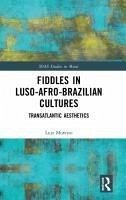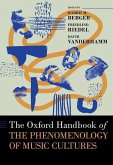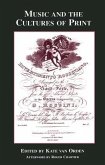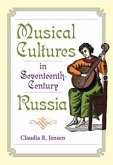- Gebundenes Buch
- Merkliste
- Auf die Merkliste
- Bewerten Bewerten
- Teilen
- Produkt teilen
- Produkterinnerung
- Produkterinnerung
Fiddles in Luso-Afro-Brazilian Cultures presents fresh data and debates drawn from extensive research to broaden the study of African music by focusing on fiddle playing, exploring rhythm aesthetics and tonal systems within cultural contexts.
Andere Kunden interessierten sich auch für
![The Oxford Handbook of the Phenomenology of Music Cultures The Oxford Handbook of the Phenomenology of Music Cultures]() The Oxford Handbook of the Phenomenology of Music Cultures205,99 €
The Oxford Handbook of the Phenomenology of Music Cultures205,99 €![Brazilian Popular Music Brazilian Popular Music]() Lorraine LeuBrazilian Popular Music131,99 €
Lorraine LeuBrazilian Popular Music131,99 €![Music and the Cultures of Print Music and the Cultures of Print]() Kate Orden (ed.)Music and the Cultures of Print198,99 €
Kate Orden (ed.)Music and the Cultures of Print198,99 €![Fiddles on the Mountain, Lively Folk Duets for Two Violas, Book One Fiddles on the Mountain, Lively Folk Duets for Two Violas, Book One]() Myanna HarveyFiddles on the Mountain, Lively Folk Duets for Two Violas, Book One15,99 €
Myanna HarveyFiddles on the Mountain, Lively Folk Duets for Two Violas, Book One15,99 €![Fiddles on the Mountain, Lively Folk Duets for Two Violins, Book One Fiddles on the Mountain, Lively Folk Duets for Two Violins, Book One]() Myanna HarveyFiddles on the Mountain, Lively Folk Duets for Two Violins, Book One15,99 €
Myanna HarveyFiddles on the Mountain, Lively Folk Duets for Two Violins, Book One15,99 €![Musical Cultures in Seventeenth-Century Russia Musical Cultures in Seventeenth-Century Russia]() Claudia R JensenMusical Cultures in Seventeenth-Century Russia48,99 €
Claudia R JensenMusical Cultures in Seventeenth-Century Russia48,99 €![Wax Poetics Journal Issue 68 (Hardcover) Wax Poetics Journal Issue 68 (Hardcover)]() Various AuthorsWax Poetics Journal Issue 68 (Hardcover)48,99 €
Various AuthorsWax Poetics Journal Issue 68 (Hardcover)48,99 €-
-
-
Fiddles in Luso-Afro-Brazilian Cultures presents fresh data and debates drawn from extensive research to broaden the study of African music by focusing on fiddle playing, exploring rhythm aesthetics and tonal systems within cultural contexts.
Hinweis: Dieser Artikel kann nur an eine deutsche Lieferadresse ausgeliefert werden.
Hinweis: Dieser Artikel kann nur an eine deutsche Lieferadresse ausgeliefert werden.
Produktdetails
- Produktdetails
- Verlag: Taylor & Francis
- Seitenzahl: 224
- Erscheinungstermin: 21. Oktober 2024
- Englisch
- Abmessung: 234mm x 156mm x 16mm
- Gewicht: 526g
- ISBN-13: 9781032774565
- ISBN-10: 1032774568
- Artikelnr.: 70600666
- Herstellerkennzeichnung
- Libri GmbH
- Europaallee 1
- 36244 Bad Hersfeld
- gpsr@libri.de
- Verlag: Taylor & Francis
- Seitenzahl: 224
- Erscheinungstermin: 21. Oktober 2024
- Englisch
- Abmessung: 234mm x 156mm x 16mm
- Gewicht: 526g
- ISBN-13: 9781032774565
- ISBN-10: 1032774568
- Artikelnr.: 70600666
- Herstellerkennzeichnung
- Libri GmbH
- Europaallee 1
- 36244 Bad Hersfeld
- gpsr@libri.de
Dr Luiz Moretto holds an honors degree in music from Santa Catarina State University and a doctorate in ethnomusicology from King's College London. He is a professional fiddle player and composer whose performances and recordings encompass various styles of African and Brazilian music, subjects that have been the focus of his research over many years.
1 Introduction: Mapping Afro-Fiddle Playing in Three Different Contexts
Busking in Lisbon First beatsUpbeat down-bow: musical identitiesAfrican
musical aesthetics? Perception, the 'sensuous' and improvisationRhythm as a
diasporic reinvention Approaching the fieldworkFiddles in transit2 The
Kriolu Violin of Cape VerdeThe archipelago at the Atlantic crossroads
Transnational culturesThe violin in Cape Verde
Antoninho Travadinha - the improviserResearch in the Ilhas do Sotavento
(Santiago)
Kim Alves
Nhô Djonzinho Alves
Nhô NaniResearch in the Ilhas do Barlavento
Francisco Sequeira (archivist) and Malaquias Costa (violinist)
César Costa
Nhô Kzik
Breka ('The Tall Man')Kriolu violin playing: a dynamic tradition3 The
Cimboa in Cape VerdeRumours of extinction A Fulbe heritage? The cimboa in
batukuThe rhythm of cimboa music
Mano Mendi and Pascoal Fernandes
Ntóni Denti d'OroTranscultural revivals4 The Cimboa Becomes the Orocongo
The transformation of the cimboa in Brazil
Gentil do OrocongoThe orocongo, the rhizome and 'creative creolisation' 5
Vanished Fiddles: Vestiges of Mozambique in BrazilInvestigating historical
traces Fiddle paintings Across the 'emaka' (ocean): the journey from east
to westThe disappearance of the one-stringed fiddle 6 The Tchakare in
MozambiqueThe Makua people
On the way to Niassa
The Makua tchakare and tchkwèsa
Between Mandimba and Mitande
Nfani Wathunia
A traditional Makua village
Almirante Bilale The Makua tchakare and a nationalist agenda
7 The Rabeca in a Brazilian Quilombo
Quilombola culture: resistance, identity and ethnic reassertion
Vale do Ribeira
Quilombos: cultural heritage and the struggle for recognition
Caiçaras, quilombos and music
Rabeca players in Quilombo do Morro Seco
Bonifácio Modesto Pereira
The fandango-rufado
The role of the rabeca
Hermes Modesto Pereira
Music and religion
Musical and social change
8 Conclusion: Creolisation and the Revival of Fiddle Traditions
The fiddle and the African diaspora
The Kriolu violin: local and overseas circuits, transnational identities
One-stringed fiddle connections
Fiddling in a quilombo: land, memory and identity
Unperceived aesthetics and disappearing traditions
Glossary of Terms
Busking in Lisbon First beatsUpbeat down-bow: musical identitiesAfrican
musical aesthetics? Perception, the 'sensuous' and improvisationRhythm as a
diasporic reinvention Approaching the fieldworkFiddles in transit2 The
Kriolu Violin of Cape VerdeThe archipelago at the Atlantic crossroads
Transnational culturesThe violin in Cape Verde
Antoninho Travadinha - the improviserResearch in the Ilhas do Sotavento
(Santiago)
Kim Alves
Nhô Djonzinho Alves
Nhô NaniResearch in the Ilhas do Barlavento
Francisco Sequeira (archivist) and Malaquias Costa (violinist)
César Costa
Nhô Kzik
Breka ('The Tall Man')Kriolu violin playing: a dynamic tradition3 The
Cimboa in Cape VerdeRumours of extinction A Fulbe heritage? The cimboa in
batukuThe rhythm of cimboa music
Mano Mendi and Pascoal Fernandes
Ntóni Denti d'OroTranscultural revivals4 The Cimboa Becomes the Orocongo
The transformation of the cimboa in Brazil
Gentil do OrocongoThe orocongo, the rhizome and 'creative creolisation' 5
Vanished Fiddles: Vestiges of Mozambique in BrazilInvestigating historical
traces Fiddle paintings Across the 'emaka' (ocean): the journey from east
to westThe disappearance of the one-stringed fiddle 6 The Tchakare in
MozambiqueThe Makua people
On the way to Niassa
The Makua tchakare and tchkwèsa
Between Mandimba and Mitande
Nfani Wathunia
A traditional Makua village
Almirante Bilale The Makua tchakare and a nationalist agenda
7 The Rabeca in a Brazilian Quilombo
Quilombola culture: resistance, identity and ethnic reassertion
Vale do Ribeira
Quilombos: cultural heritage and the struggle for recognition
Caiçaras, quilombos and music
Rabeca players in Quilombo do Morro Seco
Bonifácio Modesto Pereira
The fandango-rufado
The role of the rabeca
Hermes Modesto Pereira
Music and religion
Musical and social change
8 Conclusion: Creolisation and the Revival of Fiddle Traditions
The fiddle and the African diaspora
The Kriolu violin: local and overseas circuits, transnational identities
One-stringed fiddle connections
Fiddling in a quilombo: land, memory and identity
Unperceived aesthetics and disappearing traditions
Glossary of Terms
1 Introduction: Mapping Afro-Fiddle Playing in Three Different Contexts
Busking in Lisbon First beatsUpbeat down-bow: musical identitiesAfrican
musical aesthetics? Perception, the 'sensuous' and improvisationRhythm as a
diasporic reinvention Approaching the fieldworkFiddles in transit2 The
Kriolu Violin of Cape VerdeThe archipelago at the Atlantic crossroads
Transnational culturesThe violin in Cape Verde
Antoninho Travadinha - the improviserResearch in the Ilhas do Sotavento
(Santiago)
Kim Alves
Nhô Djonzinho Alves
Nhô NaniResearch in the Ilhas do Barlavento
Francisco Sequeira (archivist) and Malaquias Costa (violinist)
César Costa
Nhô Kzik
Breka ('The Tall Man')Kriolu violin playing: a dynamic tradition3 The
Cimboa in Cape VerdeRumours of extinction A Fulbe heritage? The cimboa in
batukuThe rhythm of cimboa music
Mano Mendi and Pascoal Fernandes
Ntóni Denti d'OroTranscultural revivals4 The Cimboa Becomes the Orocongo
The transformation of the cimboa in Brazil
Gentil do OrocongoThe orocongo, the rhizome and 'creative creolisation' 5
Vanished Fiddles: Vestiges of Mozambique in BrazilInvestigating historical
traces Fiddle paintings Across the 'emaka' (ocean): the journey from east
to westThe disappearance of the one-stringed fiddle 6 The Tchakare in
MozambiqueThe Makua people
On the way to Niassa
The Makua tchakare and tchkwèsa
Between Mandimba and Mitande
Nfani Wathunia
A traditional Makua village
Almirante Bilale The Makua tchakare and a nationalist agenda
7 The Rabeca in a Brazilian Quilombo
Quilombola culture: resistance, identity and ethnic reassertion
Vale do Ribeira
Quilombos: cultural heritage and the struggle for recognition
Caiçaras, quilombos and music
Rabeca players in Quilombo do Morro Seco
Bonifácio Modesto Pereira
The fandango-rufado
The role of the rabeca
Hermes Modesto Pereira
Music and religion
Musical and social change
8 Conclusion: Creolisation and the Revival of Fiddle Traditions
The fiddle and the African diaspora
The Kriolu violin: local and overseas circuits, transnational identities
One-stringed fiddle connections
Fiddling in a quilombo: land, memory and identity
Unperceived aesthetics and disappearing traditions
Glossary of Terms
Busking in Lisbon First beatsUpbeat down-bow: musical identitiesAfrican
musical aesthetics? Perception, the 'sensuous' and improvisationRhythm as a
diasporic reinvention Approaching the fieldworkFiddles in transit2 The
Kriolu Violin of Cape VerdeThe archipelago at the Atlantic crossroads
Transnational culturesThe violin in Cape Verde
Antoninho Travadinha - the improviserResearch in the Ilhas do Sotavento
(Santiago)
Kim Alves
Nhô Djonzinho Alves
Nhô NaniResearch in the Ilhas do Barlavento
Francisco Sequeira (archivist) and Malaquias Costa (violinist)
César Costa
Nhô Kzik
Breka ('The Tall Man')Kriolu violin playing: a dynamic tradition3 The
Cimboa in Cape VerdeRumours of extinction A Fulbe heritage? The cimboa in
batukuThe rhythm of cimboa music
Mano Mendi and Pascoal Fernandes
Ntóni Denti d'OroTranscultural revivals4 The Cimboa Becomes the Orocongo
The transformation of the cimboa in Brazil
Gentil do OrocongoThe orocongo, the rhizome and 'creative creolisation' 5
Vanished Fiddles: Vestiges of Mozambique in BrazilInvestigating historical
traces Fiddle paintings Across the 'emaka' (ocean): the journey from east
to westThe disappearance of the one-stringed fiddle 6 The Tchakare in
MozambiqueThe Makua people
On the way to Niassa
The Makua tchakare and tchkwèsa
Between Mandimba and Mitande
Nfani Wathunia
A traditional Makua village
Almirante Bilale The Makua tchakare and a nationalist agenda
7 The Rabeca in a Brazilian Quilombo
Quilombola culture: resistance, identity and ethnic reassertion
Vale do Ribeira
Quilombos: cultural heritage and the struggle for recognition
Caiçaras, quilombos and music
Rabeca players in Quilombo do Morro Seco
Bonifácio Modesto Pereira
The fandango-rufado
The role of the rabeca
Hermes Modesto Pereira
Music and religion
Musical and social change
8 Conclusion: Creolisation and the Revival of Fiddle Traditions
The fiddle and the African diaspora
The Kriolu violin: local and overseas circuits, transnational identities
One-stringed fiddle connections
Fiddling in a quilombo: land, memory and identity
Unperceived aesthetics and disappearing traditions
Glossary of Terms








